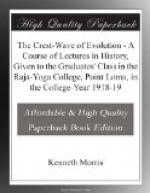centuries more, came together and was great again.
Fifteen hundred years after Ts’in Shi Hwangti
had founded China, her manvantara then having ended,
and her whole creative cycle run through, she fell
to the Mongols. Fifteen hundred years after
Julius Caesar had founded his empire, the last wretched
remnant of it fell to the Turks. But China first
compelled her conquerors to behave like Chinamen,
and then, after a century, turned them out. The
Turks never became Greek or Roman, and so far have
not quite been turned out. The roman empire disappeared,
and never reunited;—that is what has been
the matter with Europe ever since. Europe, in
her manvantara, has wasted three parts of her creative
force in wars and disunion. But China, even
in her pralaya, became a strong, united power again
under the Mings (1368-1644)—the first of
them—a native dynasty. Conquered again,
now by the Manchus, she mader her conquerors behave
like Chinamen,—imposed on them her culture;—and
went forth under their banners to conquer. The
European pralaya (630-1240) was a time barren of creation
in art and literature, and in life uttterly squalid
and lightless The Chinese pralaya, after the Mongol
Conquest, took a very long time to sink into squalidity.
The arts, which had died in Europe long before Rome
fell, lived on in China, though with ever-waning energy,
through the Mongol and well into the Ming time:
the national stability, the force of custom, was
there to carry them on. What light, what life,
what vigor was there in Rome or Constantinople a century
and a half after Alaric or Heraclius? But Ming
Yunglo, a century and a half after the fall of Sung,
reigned in great splendor; sent his armies conquering
to the Caspian, and his navies to the conquest of
Ceylon, the discovery of Africa, the gathering in
of the tribute of the Archipelago and the shores of
the Indian Ocean. Until the end of the eighteenth
century the minor arts and crafts—pottery
and bronzes—of which there was nothing
to speak of in Europe in the corresponding European
age—were flourishing wonderfully; and in
the seventeenth and eighteeenth centuries, under Kanghi
and Kienlung, China was once more a great military
power. She chased and whipped the Goorkhas down
through the Himalays and into India, only twenty years
before England fought difficult and doubtful campaigns
with those fierce little mountaineers. You may
even say she has been better off in her pralaya, in
many ways, and until recently, than most of Europe
has been in most of her manvantara. In
Kienlung’s reign, for example (1735-1795) there
were higher standards of life, more security, law,
and order, than in the Europe of Catherine of Russia,
Frederick the Great, Louis XV and the Revolution,
and the English Georges. There was far less
ferment of the Spirit, true; less possibility of progress;—but
that is merely to say that China was in pralaya, Europe
in high manvantara. The explanation is that a
stability had been imparted to that Far Eastern civilization,




